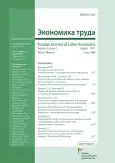Labor market equilibrium and unobserved macroeconomic indicators
- Authors: Vinokurov E.F.1
-
Affiliations:
- Central Economic and Mathematical Institute of the Russian Academy of Sciences
- Issue: Vol 10, No 8 (2023)
- Pages: 1131-1144
- Section: Articles
- URL: https://journals.rcsi.science/2410-1613/article/view/146256
- DOI: https://doi.org/10.18334/et.10.8.118903
- ID: 146256
Cite item
Abstract
About the authors
Evgeniy Fedorovich Vinokurov
Central Economic and Mathematical Institute of the Russian Academy of Sciences
Email: evinokurov@yandex.ru
Старший научный сотрудник, кандидат экономических наук
References
- Ахундова О.В., Коровкин А.Г. Опыт оценки естественного уровня безработицы в экономике России. / Научные труды: Институт народнохозяйственного прогнозирования РАН. - М.: МАКС Пресс, 2006. – 488-507 c.
- Брагин В.А., Осаковский В.В. Оценка естественного уровня безработицы в России в 1994-2003 гг.: Эмпирический анализ // Вопросы экономики. – 2004. – № 3. – c. 95-104.
- Винокуров Е.Ф. Двухфакторные функции предложения труда на макроуровне: тема с вариациями // Экономика труда. – 2023. – № 5. – c. 653-664.
- Винокуров Е.Ф. Увеличение оплаты труда в России: мультипликативный эффект // Экономическая наука современной России. – 2018. – № 4. – c. 114-125.
- Винокуров Е.Ф. Закон Оукена: ревизионистский подход // Системное моделирование социально-экономических процессов: Труды 43-й Международной научной школы-семинара имени академика С.С. Шаталина, г. Воронеж 13-18 октября 2020 г. 2021, издательство ВГУ. Воронеж, 2020. – c. 85-90.
- Винокуров Е.Ф. К вопросу об определении уровня естественной безработицы // Экономическая наука современной России. – 2012. – № 1. – c. 62-72.
- Винокуров Е.Ф. Спрос и предложение труда в макроэкономике: теоретические соображения и расчеты // Экономическая наука современной России. – 2022. – № 3. – c. 16-25.
- Винокуров Е.Ф. Чарльз Кобб и Пол Дуглас против Артура Оукена // Вестник ЦЭМИ. – 2020. – № 1.
- Капелюшников Р.И., Ощепков А.Ю. Российский рынок труда: парадоксы посткризисного развития. / Препринт WP3/2014/04. - М.: Изд. дом Высшей школы экономики, 2014. – 41 c.
- Китрар Л.А., Липкинд Т.М., Остапкович Г.В., Чусовлянов Д.С. Практика идентификации ненаблюдаемых компонент в траектории ВВП: потенциальный уровень и краткосрочные разрывы // Вопросы статистики. – 2015. – № 10. – c. 13-25.
- Нижегородцев Р.М. Иллюзия равновесия на рынке труда // Экономические стратегии. – 2005. – № 5-6. – c. 118-123.
- Орлова Е.А., Белоусов Д.Р., Галимов Д.И. О модели потенциального ВВП и разрыва выпуска для российской экономики // Проблемы прогнозирования. – 2020. – № 2. – c. 60-71.
- Российский рынок труда: тенденции, институты, структурные изменения. / Доклад Центра трудовых исследований (ЦеТИ) и Лаборатории исследований рынка труда (ЛИРТ) НИУ ВШЭ/ под редакцией В. Гимпельсона, Р. Капелюшникова и С. Рощина. - Москва: Высшая школа экономики, 2017. – 148 c.
- Cotis J.P., Elmeskov J., Mourougane A. Estimates of potential output: Benefits and pitfalls from a policy perspective. / Reichlin L. (ed.). The Euro area business cycle: stylized facts and measurement issues. - London, 2004. – 35-60 p.
- Kichian M. Measuring potential output with a state space framework. / Bank of Canada Working Paper 99-9., 1999.
- Kuttner K.N. Estimating potential output as a latent variable // Journal of Business and Economic Statistics. – 1994. – № 12(3). – p. 361-368.
- McMorrow K., Roeger W. Potential output: measurement methods, «new» economy influences and scenarios for 2001-2010 - a comparison of the EU15 and the US. / European Commission Economic Papers No. 150., 2001.
Supplementary files








